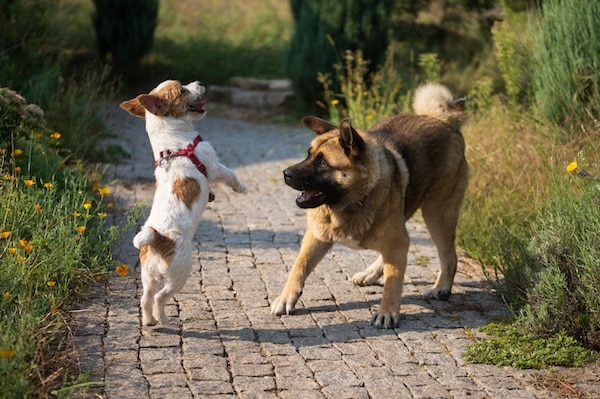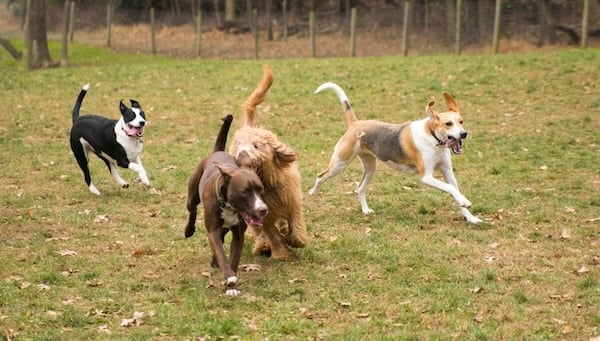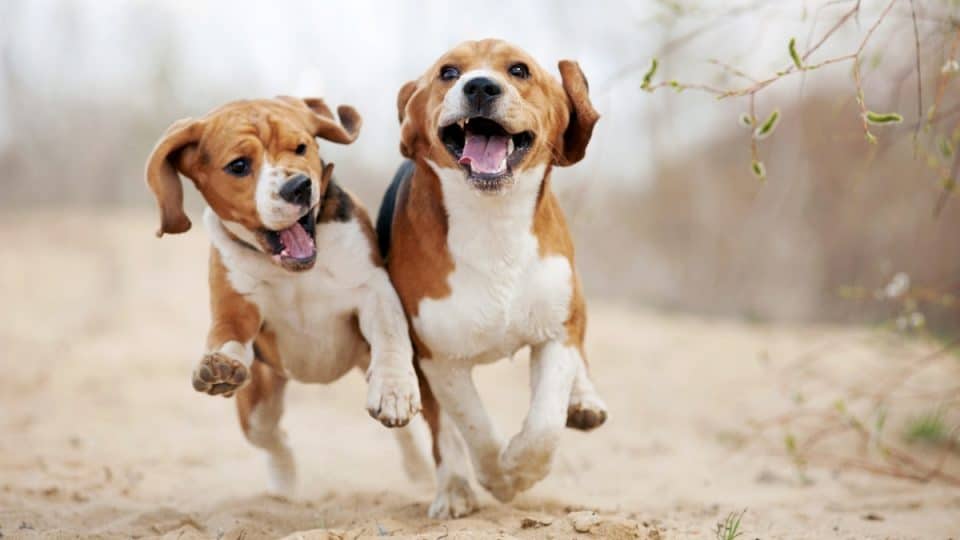- Not a substitute for professional veterinary help.
Dogs aren’t that different from humans when it comes to socializing—minus the introductory sniffing, of course. Like their two-legged counterparts, some dogs happily get along with everyone, while others have preferences about the animals they want to spend time with. In fact, many dogs are “dog selective,” meaning they prefer a small but close circle of canine friends and show disinterest or even dislike toward pups outside of this group.
While pet parents may assume their dog’s sociability is static, it can actually change throughout their pup’s life. At some point, many dog guardians may be surprised to find their once sociable pup struggling with new dogs or uninterested in making friends.
To better understand what it means to be dog selective, we turned to the experts. We spoke with two certified dog trainers: Alexandra Bassett, lead dog trainer and behavior consultant at Dog Savvy; and Nicole Kohanski, trainer, dog behavior expert, and founder of Wiggle Butt Academy. Together, they offer invaluable insights into everything a pet parent should know about dog selectivity.
Scale of Dog Selectivity and Sociability
If your pup is picky about their playmates, don’t stress. According to our experts, most dogs are either dog selective or dog tolerant.
“Dogs have a range of personalities and temperaments, and some are more dog social than others, just like some people are more outgoing than others,” says Bassett. Kohanski agrees, noting that it’s completely normal to be dog selective. “Being dog selective simply means that a dog is choosy about friends,” she says—a comforting assurance for pet parents worried about a seemingly antisocial pup.
Generally, a dog’s sociability falls somewhere on this simple four-point selectivity scale, ranging from dog social to dog aggressive.
| Definition | Behavior | Environment Adaptability | Common or Rare | |
| Dog Social | Loves the company of other dogs and will play with just about any dog. | Comfortable and happy. Shows no sign of distress, discomfort, or fear, even around new dogs. | Adaptable in nearly every situation with other dogs. | Rare. Typically seen in puppies, less so in adult dogs. |
| Dog Tolerant | Friendly but may not have a deep connection with everyone. | May not actively play or engage, but not aggressive. Often neutral with other dogs. | Generally adaptable; can tolerate a wide range of other pups and situations. | Common for adult dogs. |
| Dog Selective | Prefers interacting with only certain types of dogs over others. | May be happy and comfortable around some pups but growl or react toward others. | Can adapt with the right training and slow introductions. Requires careful monitoring in social situations. | Common for adult dogs. |
| Dog Aggressive | Typically dislikes other dogs and responds negatively, regardless of how approached. | Displays discomfort, stress, and aggressive behavior in nearly every situation. Will growl, snap, or bite other dogs. | Requires careful handling and training to be around any other dogs; may never adapt. | Rare, even for adult or senior dogs. |
Is it common for puppies to be more dog social?
While dogs are social animals, that doesn’t necessarily mean it’s normal for them to like all other dogs. Contrary to popular belief (and what’s often portrayed on TV and in film), most adult dogs aren’t hyper-social. Instead, far more are dog tolerant or dog selective.
Puppies, however, are a different story, says Kohanski. “Puppies are usually quite social,” she says. “Part of their development occurs playing with other dogs. They learn play and social cues during play with their mom and littermates in the beginning. As they age, the play with all dogs drops as their preferences develop.”

Andrii Gorb via iStock
How Does a Dog Become Dog Selective?
Dog selectiveness is itself a spectrum, ranging from mild to severe, and can even verge on dog aggression in some instances. Selectiveness can occur for a wide variety of reasons, including the following:
- Genetics or breed
- Lack of early socialization
- Past experiences with other dogs
- Aging
- Differences in size or personality
“A dog becomes selective with age and experience,” says Kohanski. “Like us, there are characteristics in friends they prefer. Some factors include play style, play frequency, vocalizations, body language, and dog manners.”
Bassett agrees that how a dog plays is a key factor in compatibility. “Some are more ‘rough and tumble’ and like to box and body slam while playing,” she says, “while others may just want to chase each other around, mock herd, and wrestle with less intensity.”
As a dog ages, mismatches in energy and play styles become even more significant. “Older dogs generally don’t enjoy playing with hyperactive puppies and are generally less tolerant of puppy energy,” says Bassett.
While there are certain indicators that suggest why a dog may be more selective than others, the reason isn’t always apparent. “We can’t always determine why some dogs like each other and why they don’t,” says Bassett. “It could be something about how they smell or how they present themselves.”
Are certain breeds more or less dog tolerant than others?
Every dog has their own unique personality traits, but some breeds may be less tolerant of other dogs. For example, breeds like the Shiba Inu and the Italian Greyhound are generally considered “introverted” and may display more dog-selective behaviors as a result.
Dog breeds that generally don’t like other dogs or are more selective include the following:
On the other hand, dog breeds considered to be more social and dog-friendly include the following:
- Cavalier King Charles Spaniel
- Collie
- Bichon Frise
- Boston Terrier
- French Bulldog
- Golden Retriever
- Labrador Retriever
Of course, these lists aren’t exact. “Each breed has a spectrum of sociability, and each individual does as well,” says Kohanski. “Golden Retrievers have a reputation for being one of the most social breeds, but the sociability spectrum applies to them, too.”

anothersteve via iStock
Can You Change a Dog’s Preferences?
While a pup’s sociability evolves throughout their life, actively changing a dog’s preferences might prove tricky.
A pup on the farthest end of the dog aggression scale will probably never become dog social. And that’s okay. Some dogs need to be the only dogs at home or in your inner circle.
Dogs in the middle of the spectrum, however, might have a better chance of becoming more neutral. With consistent socialization and training, a dog-selective pup may become more tolerant of other dogs—or at least react better to those they don’t like. This tolerance is especially helpful if your dog frequently encounters other dogs, like if you live in an apartment, travel with your pup, or take daily walks around a busy neighborhood.
In general, though, Kohanski recommends against trying to change your pup. “Because it’s normal to have preferences, I recommend adapting to the dog’s preferences instead of trying to change them.”
Understanding dog behavior, body language, and the types of dogs your pup prefers can also help, Kohanski explains. “If you know your dog’s ‘type’ and can arrange social interactions, you may see more frequent play and interaction,” she says.
Activities for Dog-Selective Dogs
“Having a dog-selective dog shouldn’t be a barrier to a happy, fulfilling life,” says Kohanski. It just requires some adjustments.
For instance, your dog-selective dog likely won’t enjoy a busy dog park. Your dog may also struggle in other environments with a lot of other dogs around, such as large boarding facilities, dog-friendly public spaces, or group training sessions. The key is to find what works best for your pup. This compromise may look like leaving your pup at home when you go to brunch, finding an in-home dog sitter, or opting for online training.
There are also plenty of enriching activities your dog-selective pup can still enjoy, such as:
- Playdates with select dog friends
- Decompression walks or hikes in places where you’re less likely to encounter other dogs
- Solo or small-group training at home or at a facility that understands dog selectivity
- Puzzle toys, scent work, and other games that use the nose and mind
The thing about dog-selective pups is that they’re not always unhappy with other dogs, especially those that tend to be more tolerant. For example, your dog may still enjoy a dog park or other public space, just not during the most popular hours.
You’ll also want to closely monitor social situations and be okay with leaving if they become uncomfortable or upset. As Kohanski says, “Understanding selectivity and accommodating preferences can help optimize your dog’s happiness and well-being.”



